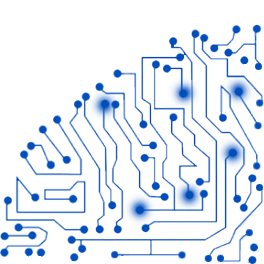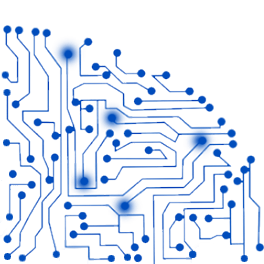

Landmarks in artificial intelligence leading to the Information Age
Introduction
Our everyday lives are nowadays greatly influenced by computers and software. Many of the even simplest tasks are unthinkable to be carried out without the current technology on hand. And society is shaped to many extends by its new achievements, as the progress in technology is so fast that often the older generations have to learn from the younger ones. Today, many people work in the field of computer science or related branches with an increasing tendency. For those and many more reasons, the current epoch is often called the digital age or information age. But how did we get there? Was it predictable to come? And who are the fathers of this sophisticated machines that are carried around in everybody’s pocket today?
On this blog, three revolutionary papers are presented, which impacted the scientific community of their time and the future. More precisely, the articles of Shannon [107], McCulloch and Pitts [74], and Turing [116] are examined to see under which circumstances they emerged and how they influenced proceeding works. Thanks to their level of abstraction, these theories yielded applications in many different fields. But this is at the same time a crucial point of caution when one wants to make direct use of them. It will be also shown in this blog that researchers need to be aware of these limitations and avoid using the theories blindly, especially when the field of research is not much related to the field for which they were originally developed for.
In Section HISTORY, it is shown that the development of mathematics and physics subsequent to the Second Industrial Revolution in the middle of the 19th century were in many points radical. This also laid the foundations for modern theories that were developed in these three papers and in the scope of “cybernetics”. In addition to that, the technological improvements during the Second World War contributed to the astonishing progress of science. It should become clear that the need of digitization and mechanical computation emerged logically from the quest of that time.
The reader dives deeper into the three landmark papers in Section THREE LANDMARK PAPERS. Moreover, she or he will understand their revolutionary impact when they aroused attention and how we are able to build devices that exceed already human capacities.
Section IMPACT focuses on the impacts those papers have on humanity. Among others, it explains the use of information theory in deep-space communication, how neural models were pioneering - the field of what became machine learning - and e.g. how the Turing test helped conceive bot detection in the Internet. It then details the intrinsic drawback of the artificial neural networks, namely that their internal functioning is extremely hard to grasp. Maybe this is a warning that one day we might not understand machine computation at all. This chapter also compares the learning processes of machines and humans and builds upon this to suggest hints for designing machines that think and learn the way human beings do. Finally, the limitations of information theory are underlined.
HISTORY
-
Statistical mechanics and quantum physics
-
Probability and computability
-
Investigating the brain
-
Long distance communications
-
World War II
-
Computing machines
-
What is cybernetics
-
Analog vs Digital
-
Learning and adaptation
-
Animal vs machine
The emergence of the information concept

THREE LANDMARK PAPERS
 Turing |  Shannon |  McCulloch&Pitts |
|---|
Technological impact:
the digital information age

Foreword
Authors

Kathleen Coutisse

Christoph Stoeffler

Ivan Di Lorenzo

Linda Wang

Nicolas Vecoven

Bertrand Ernst

Colin Smetz

Sarah Wassermann

Grégoire Mathonet

Olivier Schyns

Julie Destexhe

Marie-Claire Umutoni


Thomas Rougeau

Nicolas Albertini
This blog is the outcome of the module INGE0012 "Scientific research in engineering and its impact on innovation” on offer at the Universite de Liege for the first time in 2016-2017.
The course was offered to engineering students at the master level. It was organised around three major scientific papers published around the second World War and that have had a major impact on the information age of technology.
Students were first assigned to read the three papers, that were subsequently presented and put in context in three seminars given by three faculty members from the related disciplines.
Each student then engaged into bibliographical search with the task of identifying one “source” paper and one “impact” paper highlighting the origin and eventual technological impact of one of the three assigned landmark papers. Each student prepared a written report on those papers and gave an oral presentation to the rest of the group.
During a full week seminar through the half of the term, students presented their individual work orally and discussed how to integrate the raw material into a general blog highlighting the history and the emergence of the digital technological age. The outcome of the week was roughly the table of contents of the blog and pointers from each student report to each relevant section.
The final blog was then prepared collectively through a sequence of steps. Each section was first written by a student, then reviewed by another student, and finally revised by the author student. Reviews and Revisions were all documented and accessible to all students. Integration tasks were also distributed among students. They included reviewing entire chapters, writing introductory material, selecting figures and writing captions, migrating the final text to a blog edition, and proof-reading.
At the end of the module, each student complied an individual report summarising his or her personal contribution to each step of the entire project. Students were also asked to identify and to comment on what they had learned.
A lot of feedback about the organisation and steering of the module is not included in this foreword but will hopefully benefit future editions. Overall, the response and engagement of the students in this unusual module has been overly positive. Many acknowledged that a key outcome of the module had been to realise that science and technology have a history, and that the knowing past is a great asset to shape the future.











